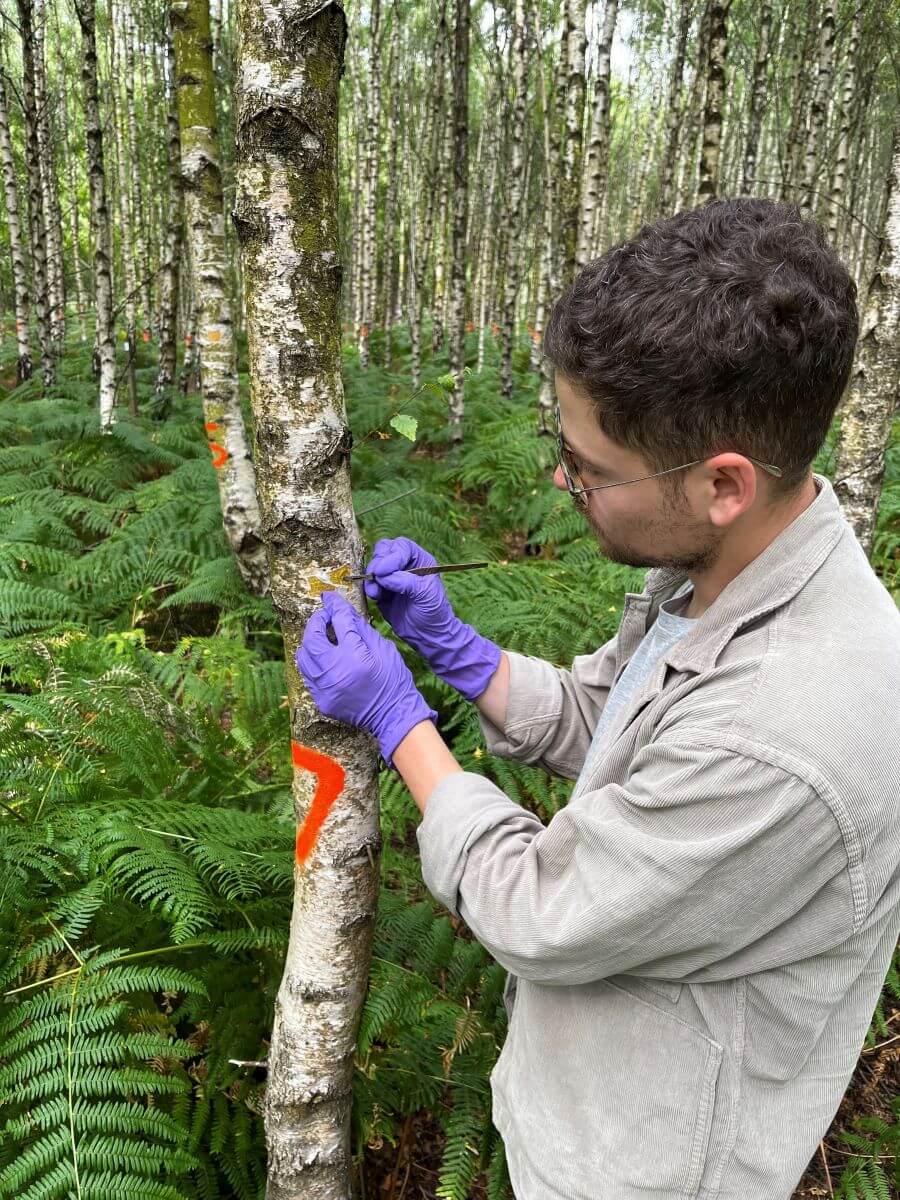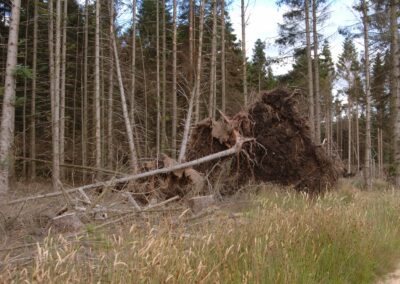Understanding the genetic basis of silver birch adaptation to local environments and disease
Project leads Dr Richard Whittet, Dr Joan Cottrell, Dr Domen Finžgar | Forest Research; Prof. Richard Buggs | Royal Botanic Gardens, Kew
Lead organisation Forest Research; Royal Botanic Gardens, Kew
Collaborators Dr Jo Clark | Future Trees Trust
Project status Complete (April 2022 – March 2025)
Project funding £675,306
Research outcome Adaptation
Context
Silver birch (Betula pendula) is the second-most abundant broadleaved tree species in Britain by area, with the past 20 years seeing significant growth in the planting of birch for the creation of native woodlands and timber. However, a greater understanding of genetic adaptation is now required in order to plant trees that are resilient to climate change and dieback caused by native pathogens.
This interdisciplinary project brings together Forest Research expertise in forest genetics and tree health with genomic and bioinformatic skills at Kew. Forest Research holds well-designed provenance trials for silver birch in contrasting environments, which represent a comprehensive range of British populations. New assessments of performance and disease incidence or severity in these trials will be combined with innovative genomic approaches, to explore the genetic control of adaptive traits and prospects for adaptation to environmental change.
Research aims and objectives
Aims
This work aims to guide future planting of silver birch by providing an improved knowledge of:
- The distribution of adaptive variation (including disease susceptibility) in British silver birch populations and the climatic factors that drive genetic adaptation.
- The genomic control of a range of adaptive traits in British silver birch including disease resistance.
Objectives
- This project will sequence the genomes of over 2000 silver birch trees from native British populations grown in three provenance trials planted in 2003. These trees have been periodically evaluated for growth and stem form over the past two decades and reveal a latitudinal pattern of variation for those traits in silver birch. In this study, we will gather new data on tree performance, such as stress tolerance, water use efficiency, and disease resistance, and seek associations between phenotype, genotype, and the environment.
- This will be by far the most comprehensive effort in genetically characterising a native tree species in the UK, and will support long-term efforts in tree improvement.
- Combining genomic analysis from provenance trials with those obtained from the genome-environment association (GEA) study conducted in the Centre for Forest Protection pilot year will allow us to cross-validate both approaches. This two-pronged methodology will generate an understanding of how natural selection operates on silver birch, the genetic basis of adaptation, and how silver birch may respond to environmental change.
Expected outcomes
- Peer reviewed papers linking environment, genotype, and phenotype.
- Publicly accessible genome-wide read data and single nucleotide polymorphism (SNP) data for silver birch.
- Popular article summarising factors influencing adaptation and choices of planting stock in silver birch.
- Outline plans for molecular-informed breeding of silver birch.
Further resources linked to this project
Watch a short talk on this project
In this talk, Dr Domen Finžgar (Forest Research), Dr Rômulo Carleial & Phoebe Swift (Royal Botanic Gardens, Kew) present research on exploring genetic and plastic adaptation of birch to different environments.
This talk was part of the ‘Planting, Natural Colonisation, and Adaptation: Oak and Birch’ webinar originally broadcast by the Centre for Forest Protection on 24 March 2025.
CFP Pilot Project (2021-2022)
See previous research on this topic from CFP pilot project: Scoping multi-species genotyping for genome-environment association study.

Sampling silver birch
Glossary & Key Terms
Adaptive variation
The genetic differences among populations of a tree species that influence how well individual trees can survive and thrive under different environmental conditions, especially in response to climatic factors and disease pressures.
Bioinformatics
An interdisciplinary field that uses computer science, statistics, and biology to analyse and interpret biological data.
Broadleaved
A category of trees that have wide, flat leaves rather than needle-like leaves. A category of trees that have wide, flat leaves rather than needle-like leaves. These trees are usually deciduous and lose their leaves in winter.
Genetic control
The extent to which specific traits are determined by the tree’s genetic makeup and can be inherited by its offspring.
Genome
The complete set of genetic material in an organism. It includes all of the organism’s DNA, which contains the instructions needed for growth, development, functioning, and reproduction.
Genome-environment association (GEA)
The statistical relationship between genetic variations (genotypes) and environmental factors. It is a method used to study how organisms adapt to their local environments by identifying specific genes that are associated with particular environmental conditions.
Genomic analysis
Analysis of the genetic information obtained from the DNA of tree populations.
Genomic control
The specific influence of DNA-level variation, such as genes, loci, and single nucleotide polymorphisms (SNPs), on adaptive traits in trees. It goes beyond general heritability to identify which parts of the genome are responsible for traits like disease resistance, stress tolerance, water use efficiency, and growth and stem form.
Genomics
The study of an organism’s complete set of DNA, including all of its genes, and how that DNA interacts within the organism and with its environment.
Genotype
The genetic make-up of the tree/plant.
Molecular-informed breeding
The use of DNA-based technologies to enhance traditional tree breeding programs, accelerating the development of trees with desired traits like disease resistance and climate resilience.
Pathogen
An organism or agent that can cause disease. Pathogens include viruses, bacteria, fungi, and protists. They can infect a wide range of hosts, including plants and animals.
Phenotype
Observable characteristics, such as height, biomass, leaf shape and so on.
Provenance
A forestry term used to describe the location of the stand from which reproductive material (seeds or cuttings) was collected.
Silver birch (Betula pendula)
Silver birch is one of two native birches in Britain and was historically an important source of wood for fuel, charcoal and small wood products, particularly wooden bobbins. It was not recognised as a timber tree and the increased use of plastics saw it fall out of general use. There is increasing interest in the potential for birch as a productive forest species. Silver birch is a native species and is categorised as a principal tree species. For more information, see Silver birch (SBI) – Forest Research.
Single nucleotide polymorphism (SNP)
A variation at a single position in a DNA sequence among individuals.
Share this project on social media
Related Projects
Our Partners
Social media
Explore
Newsletter
Contact
© 2022 Centre for Forest Protection. All rights reserved.


